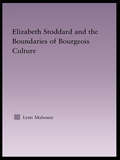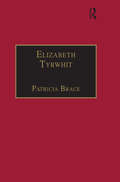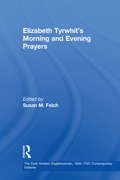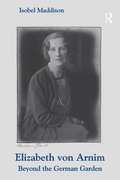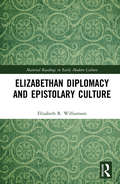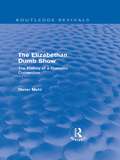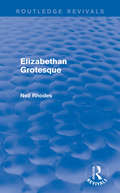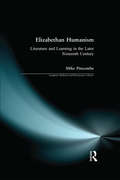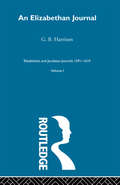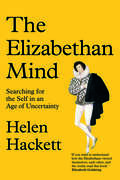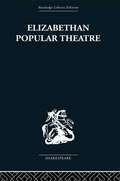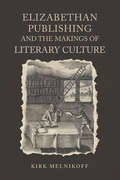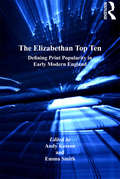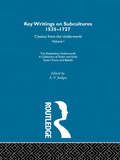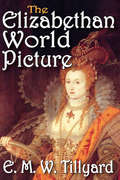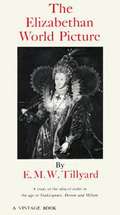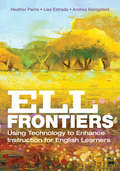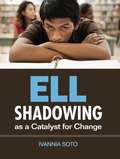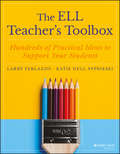- Table View
- List View
Elizabeth Stoddard & the Boundaries of Bourgeois Culture (Studies in Major Literary Authors #31)
by Lynn MahoneyFirst published in 2004. Routledge is an imprint of Taylor & Francis, an informa company.
Elizabeth Tyrwhit: Printed Writings 1500–1640: Series I, Part Three, Volume 1 (The Early Modern Englishwoman: A Facsimile Library of Essential Works & Printed Writings, 1500-1640: Series I, Part Three #Pt. 2)
by Patricia BraceElizabeth Tyrwhit's 1574 Morning and Euening Praiers is a collection of private prayers, a class of book that grew in both popularity and volume with the establishment of Protestantism in England from the mid-century on. These prayers first appeared in a tiny gilt girdle-book alongside the Litany, an incomplete copy of The Queen's Prayers by Katherine Parr and an incomplete copy of The Kalendar which are also reproduced in this facsimile edition.
Elizabeth Tyrwhit's Morning and Evening Prayers (The Early Modern Englishwoman, 1500-1750: Contemporary Editions)
by Susan M. FelchIn 1574, Christopher Barker published a volume of prayers and poems collected and composed by Elizabeth Tyrwhit, an intimate member of Katherine Parr's circle, governess to the princess Elizabeth, wife of a Tudor court functionary, and a wealthy widow. Later, Tyrwhit's Morning and Evening Prayers was selected by Thomas Bentley to be republished in his 1582 compilation of devotional works, The Monument of Matrones. This volume presents critical, old-spelling editions of both versions of Morning and Evening Prayers. Placing them side by side, Susan Felch discloses that the second version contains nearly a quarter more material that the first, and is organized quite differently. Felch convincingly argues that the additional material and revised arrangement of the longer version are likely copied direct from another, no longer extant authorial version, either printed or manuscript. In the volume's introduction, Felch provides background on Tyrwhit's life and family, including new information unearthed in her research; and sets Tyrwhit's work within the context of sixteenth- century English prayerbooks. Felch here posits that Tyrwhit's reorganization and framing of traditional material indicates her own considerable creativity. The Textual Notes and Appendix A compare the 1574 and 1582 versions and identify the source texts from which Tyrwhit derives her prayers and poems. The edition is completed by an autograph note by Tyrwhit; a discussion of the Tyrwhit family connections, and several versions of the rhymed Hours of the Cross as background to Tyrwhit's rendition entitled, 'An Hymne of the Passion of Christ'.
Elizabeth von Arnim: Beyond the German Garden (Katherine Mansfield Studies)
by Isobel MaddisonIn the first book-length treatment of Elizabeth von Arnim's fiction, Isobel Maddison examines her work in its historical and intellectual contexts, demonstrating that von Arnim's fine comic writing and complex and compelling narrative style reward close analysis. Organised chronologically and thematically, Maddison's book is informed by unpublished material from the British and Huntington Libraries, including correspondence between von Arnim, her publishers and prominent contemporaries such as H.G. Wells, Bertrand Russell and her cousin Katherine Mansfield -- whose early modernist prose is seen as indebted to von Arnim's earlier literary influence. Maddison's exploration of the novelist's critical reception is situated within recent discussions of the ’middlebrow’ and establishes von Arnim as a serious author among her intellectual milieu, countering the misinformed belief that the author of such novels as Elizabeth and Her German Garden, The Caravaners, The Pastor's Wife and Vera wrote light-hearted fiction removed from gritty reality. On the contrary, various strands of socialist thought and von Arnim's wider political beliefs establish her as a significant author of British anti-invasion literature while weighty social issues underpin much of her later writing.
Elizabethan and Jacobean Reappropriation in Contemporary British Drama
by Graham SaundersThis book examines British playwrights' responses to the work of Shakespeare and his contemporaries since 1945, from Tom Stoppard's Rosencrantz and Guildenstern are Dead to Sarah Kane's Blasted and Jez Butterworth's Jerusalem. Using the work of Julie Sanders and others working in the fields of Adaptation Studies and intertextual criticism, it argues that this relatively neglected area of drama, widely considered to be adaptation, should instead be considered as appropriation - as work that often mounts challenges to the ideologies and orthodoxies within Elizabethan and Jacobean drama, and questions the legitimacy and cultural authority of Shakespeare's legacy. The book discusses the work of Howard Barker, Peter Barnes, Edward Bond, Howard Brenton, David Edgar, Elaine Feinstein and the Women's Theatre Group, David Greig, Sarah Kane, Dennis Kelly, Bernard Kopps, Charles Marowitz, Julia Pascal and Arnold Wesker.
The Elizabethan Country House Entertainment
by Elizabeth Zeman KolkovichThis is the first full-length critical study of country house entertainment, a genre central to late Elizabethan politics. It shows how the short plays staged for the Queen at country estates like Kenilworth Castle and Elvetham shaped literary trends and intervened in political debates, including whether women made good politicians and what roles the church and local culture should play in definitions of England. In performance and print, country house entertainments facilitated political negotiations, rethought gender roles, and crafted regional and national identities. In its investigation of how the hosts used performances to negotiate local and national politics, the book also sheds light on how and why such entertainments enabled female performance and authorship at a time when English women did not write or perform commercial plays. Written in a lively and accessible style, this is fascinating reading for scholars and students of early modern literature, theatre, and women's history.
Elizabethan Diplomacy and Epistolary Culture (Material Readings in Early Modern Culture)
by Elizabeth R. WilliamsonA new account of Elizabethan diplomacy with an original archival foundation, this book examines the world of letters underlying diplomacy and political administration by exploring a material text never before studied in its own right: the diplomatic letter-book. Author Elizabeth R. Williamson argues that a new focus on the central activity of information gathering allows us to situate diplomacy in its natural context as one of several intertwined areas of crown service, and as one of the several sites of production of political information under Elizabeth I. Close attention to the material features of these letter-books elucidates the environment in which they were produced, copied, and kept, and exposes the shared skills and practices of diplomatic activity, domestic governance, and early modern archiving. This archaeological exploration of epistolary and archival culture establishes a métier of state actor that participates in – even defines – a notably early modern growth in administration and information management. Extending this discussion to our own conditions of access, a new parallel is drawn across two ages of information obsession as Williamson argues that the digital has a natural place in this textual history that we can no longer ignore. This study makes significant contributions to epistolary culture, diplomatic history, and early modern studies more widely, by showing that understanding Elizabethan diplomacy takes us far beyond any single ambassador or agent defined as such: it is a way into an entire administrative landscape and political culture.
The Elizabethan Dumb Show: The History of a Dramatic Convention (Routledge Revivals)
by Dieter MehlFirst published in English in 1965, this book discusses the roots and development of the dumb show as a device in Elizabethan drama. The work provides not only a useful manual for those who wish to check the occurrence of dumb shows and the uses to which they are put; it also makes a real contribution to a better understanding of the progress of Elizabethan drama, and sheds new light on some of the lesser known plays of the period.
Elizabethan Grotesque (Routledge Revivals)
by Neil RhodesThe comic grotesque is a powerful element in a great deal of Elizabethan literature, but one which has attracted scant critical attention. In this study, first published in 1980, Neil Rhodes examines the nature of the grotesque in late sixteenth-century culture, and shows the part it played in the development of new styles of comic prose and drama in Elizabethan England. In defining ‘grotesque’, the author considers the stylistic techniques of Rabelais and Aretino, as well as the graphic arts. He discusses the use of the grotesque in Elizabethan pamphlet literature and the early satirical journalists such as Nashe, and argues that their work in turn stimulated the growth of satirical drama at the end of the century. The second part of the book explains the importance of Nashe’s achievement for Shakespeare and Jonson, concluding that the linguistic resources of English Renaissance comedy are peculiarly – and perhaps uniquely – physical.
Elizabethan Grotesque
by Neil RhodesDescribes a type of drama first introduced in the 1590s. Instances include material by many playwrights--Johnson, Shakespeare, Marlowe, et al. Contains many footnotes.
Elizabethan Humanism: Literature and Learning in the Later Sixteenth Century (Longman Medieval and Renaissance Library)
by Michael PincombeThe term 'humanist' originally referred to a scholar of Classical literature. In the Renaissance and particularly in the Elizabethan age, European intellectuals devoted themselves to the rediscovery and study of Roman and Greek literature and culture. This trend of Renaissance thought became known in the 19th century as 'humanism'. Often a difficult concept to understand, the term Elizabethan Humanism is introduced in Part One and explained in a number of different contexts. Part Two illustrates how knowledge of humanism allows a clearer understanding of Elizabethan literature, by looking closely at major texts of the Elizabethan period which include Spenser's, 'The Shepherd's Calendar'; Marlowe's 'Faustus' and Shakespeare's 'Hamlet'.
An Elizabethan Journal V1
by G.B. HarrisonFirst Published in 1999. Routledge is an imprint of Taylor & Francis, an informa company.
Elizabethan Literature and the Law of Fraudulent Conveyance: Sidney, Spenser, and Shakespeare
by Charles RossThis book investigates the origins, impact, and outcome of the Elizabethan obsession with fraudulent conveyancing, the part of debtor-creditor law that determines when a court can void a transfer of assets. Focusing on the years between the passage of a key statute in 1571 and the court case that clarified the statute in 1601, Charles Ross convincingly argues that what might seem a minor matter in the law was in fact part of a wide-spread cultural practice. The legal and literary responses to fraudulent conveyancing expose ethical, practical, and jurisprudential contradictions in sixteenth-century English, as well as modern, society. At least in English Common Law, debt was more pervasive than sex. Ross brings to this discussion a dazzling knowledge of early modern legal practice that takes the conversation out of the universities and Inns of Court and brings it into the early modern courtroom, the site where it had most relevance to Renaissance poets and playwrights. Ross here examines how during the thirty years in which the law developed, Sidney, Spenser, and Shakespeare wrote works that reflect the moral ambiguity of fraudulent conveyancing, which was practiced by unscrupulous debtors but also by those unfairly oppressed by power. The book starts by showing that the language and plot of Shakespeare's Merry Wives of Windsor continually refers to this cultural practice that English society came to grips with during the period 1571-1601. The second chapter looks at the social, political, and economic climate in which Parliament in 1571 passed 13 Eliz. 5, and argues that the law, which may have been used to oppress Catholics, was probably passed to promote business. The Sidney chapter shows that Henry Sidney, as governor of Ireland (a site of religious oppression), and his son Philip were, surprisingly, on the side of the fraudulent conveyors, both in practice and imaginatively (Sidney's Arcadia is the first of several works to associate fraudulent conveyancing with the abduction of women). The fourth chapter shows that Edmund Spenser, who as an official in Ireland rails against fraudulent conveyors, nonetheless includes a balanced assessment of several forms of the practice in The Faerie Queene. Chapter five shows how Sir Edward Coke's use of narrative in Twyne's Case (1601) helped settle the issue of intentionality left open by the parliamentary statute. The final chapter reveals how the penalty clause of the Elizabethan law accounts for the punishment Portia imposes on Shylock at the end of The Merchant of Venice. The real strength of the book lies in Ross's provocative readings of individual cases, which will be of great use to literary critics wrestling with the applications of legal theory to the interpretation of individual texts. This study connects a major development in the law to the literature of the period, one that makes a contribution not only to the law but also to literary studies and political and social history.
The Elizabethan Mind: Searching for the Self in an Age of Uncertainty
by Helen HackettThe first comprehensive guide to Elizabethan ideas about the mind What is the mind? How does it relate to the body and soul? These questions were as perplexing for the Elizabethans as they are for us today—although their answers were often startlingly different. Shakespeare and his contemporaries believed the mind was governed by the humours and passions, and was susceptible to the Devil&’s interference. In this insightful and wide-ranging account, Helen Hackett explores the intricacies of Elizabethan ideas about the mind. This was a period of turbulence and transition, as persistent medieval theories competed with revived classical ideas and emerging scientific developments. Drawing on a wealth of sources, Hackett sheds new light on works by Shakespeare, Marlowe, Sidney, and Spenser, demonstrating how ideas about the mind shaped new literary and theatrical forms. Looking at their conflicted attitudes to imagination, dreams, and melancholy, Hackett examines how Elizabethans perceived the mind, soul, and self, and how their ideas compare with our own.
The Elizabethan Player: Contemporary Stage Representation (Routledge Library Editions: Renaissance Drama)
by David Albert MannIn this book, first published in 1991, David Mann argues for more attention to the performer in the study of Elizabethan plays and less concern for their supposed meanings and morals. He concentrates on a collection of extracts from plays which show the Elizabethan actor as a character onstage. He draws from the texts a range of issues concerning performance practice: the nature of iterance; doubling and its implications for presentational acting; the importance of clowning and improvisation; and the effects of audience and venue on the dynamics of performance. The author suggests that the stage representation of players is in part a nostalgic farewell to the passing of an impure but perhaps more vital theatre, and in part an acknowledgement of the threat the adult theatre’s growing sophistication offered to its institutional and adolescent rivals. This title will be of interest to students of Drama and Performance.
Elizabethan Popular Theatre: Plays in Performance
by Michael HattawayElizabethan Popular Theatre surveys the Golden Age of English popular theatre: the 1590s, the age of Marlowe and the young Shakespeare. The book describes the staging practices, performance conditions and acting techniques of the period, focusing on five popular dramas: The Spanish Tragedy, Mucedorus, Edward II, Doctor Faustus and Titus Andronicus, as well as providing a comprehensive history of a variety of contemporary playhouse stages, performances, and players.
Elizabethan Publishing and the Makings of Literary Culture (Studies in Book and Print Culture)
by Kirk MelnikoffElizabethan Publishing and the Makings of Literary Culture explores the influence of the book trade over English literary culture in the decades following incorporation of the Stationers’ Company in 1557. Through an analysis of the often overlooked contributions of bookmen like Thomas Hacket, Richard Smith, and Paul Linley, Kirk Melnikoff tracks the crucial role that bookselling publishers played in transmitting literary texts into print as well as energizing and shaping a new sphere of vernacular literary activity. The volume provides an overview of the full range of practises that publishers performed, including the acquisition of copy and titles, compiling, alteration to texts, reissuing, and specialization. Four case studies together consider links between translation and the travel narrative; bookselling and authorship; re-issuing and the Ovidian narrative poem; and specialization and professional drama. Works considered include Shakespeare’s Hamlet, Thévet’s The New Found World, Constable’s Diana, and Marlowe’s Dido, Queen of Carthage. This exciting new book provides both a complement and a counter to recent studies that have turned back to authors and out to buyers and printing houses as makers of vernacular literary culture in the second half of the sixteenth century.
The Elizabethan Top Ten: Defining Print Popularity in Early Modern England (Material Readings in Early Modern Culture)
by Emma SmithEngaging with histories of the book and of reading, as well as with studies of material culture, this volume explores ’popularity’ in early modern English writings. Is ’popular’ best described as a theoretical or an empirical category in this period? How can we account for the gap between modern canonicity and early modern print popularity? How might we weight the evidence of popularity from citations, serial editions, print runs, reworkings, or extant copies? Is something that sells a lot always popular, even where the readership for print is only a small proportion of the population, or does popular need to carry something of its etymological sense of the public, the people? Four initial chapters sketch out the conceptual and evidential issues, while the second part of the book consists of ten short chapters-a ’hit parade’- in which eminent scholars take a genre or a single exemplar - play, romance, sermon, or almanac, among other categories-as a means to articulate more general issues. Throughout, the aim is to unpack and interrogate assumptions about the popular, and to decentre canonical narratives about, for example, the sermons of Donne or Andrewes over Smith, or the plays of Shakespeare over Mucedorus. Revisiting Elizabethan literary culture through the lenses of popularity, this collection allows us to view the subject from an unfamiliar angle-in which almanacs are more popular than sonnets and proclamations more numerous than plays, and in which authors familiar to us are displaced by names now often forgotten.
The Elizabethan Underworld - a collection of Tudor and Early Stuart Tracts and Ballads: Previously published 1930 and 1965 (Key Writings On Subcultures, 1535-1727 Ser. #Vol. 1)
by A. V. JudgesThe Elizabethan Underworld collects together sixteen of the more important tracts from the sixteenth and early seventeenth centuries dealing with the lives and misdoings of thieves, rogues, and tricksters. For the most part the original authors were men of experience - watchmen, constables and those who drifted into the London underworld and learnt its tricks. A thorough introduction contributes a full historical background and outlines contemporary social contexts.
The Elizabethan World Picture
by E. M. W. TillyardThis illuminating account of ideas of world order prevalent in the Elizabethan Age and later is an indispensable companion for readers of the great writers of the sixteenth and seventeenth centuries Shakespeare and the Elizabethan dramatists, Donne and Milton, among many others. The basic medieval idea of an ordered Chain of Being is studied by Tillyard in the process of its various transformations by the dynamic spirit of the Renaissance. Among his topics are: Angels; the Stars and Fortune; the Analogy between Macrocosm and Microcosm; the Four Elements; the Four Humors; Sympathies; Correspondences; and the Cosmic Dance ideas and symbols that inspirited the imaginations not only of the Elizabethans, but also of the Renaissance as such.This idea of cosmic order was one of the genuine ruling ideas of the Elizabethan Age, and perhaps the most characteristic. Such ideas, like our everyday manners, are the least disputed and the least paraded in the creative literature of the time. The province of this book is some of the notions about the world and man that were quite frequently taken for granted by the ordinary educated Elizabethan; the commonplaces too familiar for the poets to make detailed use of, except in explicitly educational passages, but essential as basic assumptions and invaluable at moments of high passion.The objective of The Elizabethan World Picture is to extract and explain the most ordinary beliefs about the constitution of the world as pictured in the Elizabethan Age and through this exposition to help the ordinary reader to understand and to enjoy the great writers of the age. In attempting this, Tillyard has brought together a number of pieces of elementary lore. This classic text is a convenient factual aid to extant interpretations of some of Spenser, Donne, or Milton.
The Elizabethan World Picture
by E. M. W. TillyardMy object then is to extract and expound the most ordinary beliefs about the constitution of the world as pictured in the Elizabethan age and through this exposition to help the ordinary reader to understand and to enjoy the great writers of the age. In attempting this I have incidentally brought together a number of pieces of elementary lore which I have not found assembled elsewhere. This book may actually be a convenient factual aid to the bare construing of some of Spenser or Donne or Milton.
ELL Frontiers: Using Technology to Enhance Instruction for English Learners
by Andrea M. Honigsfeld Heather Parris Lisa M. EstradaYour GPS for improving ELLs’ academic outcomes Grounded in the latest research on EL language and literacy development and technology integration, this timely book will serve as your road map for navigating the exciting new frontier of digital instruction. Learn how to improve academic outcomes, enhance language acquisition, and cultivate digital citizenship through ELL Frontiers’: An overview of current digital age learning experiences and trends Step-by-step guides to implementing technology-infused lessons that are specifically adapted for English learners, including a sample lesson seed in each chapter Authentic vignettes of current uses of technology in the classroom Professional Learning Network questions for group discussion
ELL Frontiers: Using Technology to Enhance Instruction for English Learners
by Andrea M. Honigsfeld Heather Parris Lisa M. EstradaYour GPS for improving ELLs’ academic outcomes Grounded in the latest research on EL language and literacy development and technology integration, this timely book will serve as your road map for navigating the exciting new frontier of digital instruction. Learn how to improve academic outcomes, enhance language acquisition, and cultivate digital citizenship through ELL Frontiers’: An overview of current digital age learning experiences and trends Step-by-step guides to implementing technology-infused lessons that are specifically adapted for English learners, including a sample lesson seed in each chapter Authentic vignettes of current uses of technology in the classroom Professional Learning Network questions for group discussion
ELL Shadowing as a Catalyst for Change
by Ivannia M. SotoExperience a day in the life of an ELL What if you could barely understand what your teacher was saying? ELL shadowing helps teachers experience the classroom from the student’s point of view. The author describes how to implement this easily accessible form of professional development, outlines specific strategies for adapting instruction to engage ELLs, and provides supporting videos on a companion website. Benefits include: Increased teacher sensitivity to ELLs’ school experiences A heightened sense of urgency to help ELLs learn academic language and content Improved classroom instruction that spreads throughout schools and districts More engaged students who are more likely to stay in school and reach their potential
The ELL Teacher's Toolbox: Hundreds of Practical Ideas to Support Your Students (The Teacher's Toolbox Series)
by Larry Ferlazzo Katie Hull SypnieskiPractical strategies to support your English language learners The ELL Teacher’s Toolbox is a practical, valuable resource to be used by teachers of English Language Learners, in teacher education credential programs, and by staff development professionals and coaches. It provides hundreds of innovative and research-based instructional strategies you can use to support all levels of English Language Learners. Written by proven authors in the field, the book is divided into two main sections: Reading/Writing and Speaking/Listening. Each of those sections includes “Top Ten” favorites and between 40 and 70 strategies that can be used as part of multiple lessons and across content areas. Contains 60% new strategies Features ready-to-use lesson plans Includes reproducible handouts Offers technology integration ideas The percentage of public school students in the U.S. who are English language learners grows each year—and with this book, you’ll get a ton of fresh, innovative strategies to add to your teaching arsenal.
